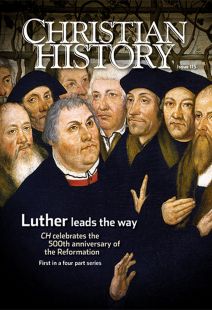Mother of the Reformation
While Henry VIII had three wives named Catherine, Martin Luther had only one. However, for one of the more famous spouses in history, little evidence survives about Katharine von Bora Luther.
She was born in January of 1499, educated in at least two convents after the remarriage of her father when she was six, and eventually became a nun at age 16 at the Cistercian convent in Nimbschen. The Reformation arrived in Nimbschen by 1519, and Luther’s influence penetrated the convent, affecting at least some residents, who soon sought to leave.
When families failed to remove their eager daughters (quite possibly because they had no economic provision for them at home), a small group of nuns applied for Luther’s help. He arranged for a local merchant who regularly delivered goods to the convent to leave with, instead of empty barrels, 12 young women hidden in his wagon. Nine of them made their way to Wittenberg in April 1523. When the nuns arrived, one observer wrote, “A wagon load of vestal virgins has just come to town all the more eager for marriage than life. May God give them husbands lest worse befall.”
By 1525 Katharine was the final ex-nun left without a husband. Although she had several suitors, she rejected them all, finally declaring that she would only marry either Nicholas von Amsdorf (one of Luther’s close colleagues) or Dr. Luther himself. She and Martin married in June of 1525, and she then found herself thrust into a public spotlight of largely negative attention.
It is likely, though, that Katharine lived without much direct exposure to the slanderous personal attacks on her marriage. Though educated and certainly able to read, even in Latin, she may have been too busy to care much about public opinion outside of her own local area. The care of the Luthers’ large household required great time and effort. Katharine managed a garden and several distant farms, the stables and kitchen, a brewery, and all the duties and servants that went along with them. She also had six children in the space of eight years—one daughter died in infancy, another died at 13.
The plague occasionally haunted Wittenberg, pushing Katharine into the healer’s role. Her home, a former Augustinian cloister, was large and always filled with family, friends, and Luther’s students who were frequent boarders (see “Did you know?,” inside front cover). Martin wrote that he did not love Katharine when they married, and he was afraid that she was proud. “I am not madly in love,” he said to one friend, “but I cherish my wife.” To another: “Other women have worse faults.“ But he quickly developed deep affection, calling her “Lord Katie” and “my rib,” and declaring “I wouldn’t give up my Katie for France or for Venice.” She clearly supported and respected his work, and while no doormat, she accepted her own vocation as being that of Christian wife and mother, the only calling Luther saw open for women. He once remarked, “In domestic affairs I defer to Katie. Otherwise I am led by the Holy Ghost.”
After Martin’s death in 1546, the family lost much of the financial support they had received while he was alive. War and plague forced them to flee Wittenberg several times, and Katharine was never able to regain stability.
She wrote of Martin after his death, “He gave so much of himself in service not only to one town or to one country, but to the whole world. … My sorrow is so deep that no words can express my heartbreak. I can neither eat nor drink, not even sleep.” In 1552 she was injured in an accident while moving to a new house. She died from her injuries at the age of 53, leaving four adult children and an enduring spiritual and social legacy.
 Christian History’s 2015–2017 four-part Reformation series is available as a four-pack. This set includes issue #115 Luther Leads the Way; issue #118 The People’s Reformation; issue #120 Calvin, Councils, and Confessions; and issue#122 The Catholic Reformation. Get your set today. These also make good gifts.
Christian History’s 2015–2017 four-part Reformation series is available as a four-pack. This set includes issue #115 Luther Leads the Way; issue #118 The People’s Reformation; issue #120 Calvin, Councils, and Confessions; and issue#122 The Catholic Reformation. Get your set today. These also make good gifts.
By Beth Kreitzer
[Christian History originally published this article in Christian History Issue #115 in 2015]
Next articles
Editor’s note: Luther leads the way
This marks the first of a Reformation series in honor of its fifth centenary
Jennifer Woodruff TaitThe man who painted the Reformation
Lucas Cranach gave us indelible images of the Reformation
Paul Thigpen and the editorsAfter the revolution
The beginning of the Reformation was not the end of Luther’s troubles
Mark U. Edwards Jr.What did Luther know and when did he know it?
When did Luther discover justification by faith?
Edwin Woodruff TaitSupport us
Christian History Institute (CHI) is a non-profit Pennsylvania corporation founded in 1982. Your donations support the continuation of this ministry
Donate



